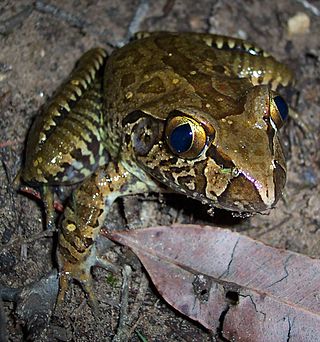
Conondale National Park is 130 km north of Brisbane in the Sunshine Coast Hinterland near the town of Conondale in the south east Queensland bioregion. The park covers an area of 35,648 hectares protecting large areas of subtropical rainforest, woodlands, wet and dry sclerophyll forest including Queensland's tallest tree. The park contains areas of regenerating forest which have been previously logged; areas of forest plantations also border the park. The park is currently managed by the Queensland Government under the Nature Conservation Act 1992.

In conservation biology, a flagship species is a species chosen to raise support for biodiversity conservation in a given place or social context. Definitions have varied, but they have tended to focus on the strategic goals and the socio-economic nature of the concept, to support the marketing of a conservation effort. The species need to be popular, to work as symbols or icons, and to stimulate people to provide money or support.

The Amsterdam albatross or Amsterdam Island albatross,, is a large albatross which breeds only on Amsterdam Island in the southern Indian Ocean. It was only described in 1983, and was thought by some researchers to be a sub-species of the wandering albatross, D. exulans. BirdLife International and the IOC recognize it as a species, James Clements does not, and the SACC has a proposal on the table to split the species. More recently, mitochondrial DNA comparisons between the Amsterdam albatross, the wandering albatross Diomedea exulans, the Antipodean albatross D. antipodensis and the Tristan albatross D. dabbenena, provide clear genetic evidence that the Amsterdam albatross is a separate species.
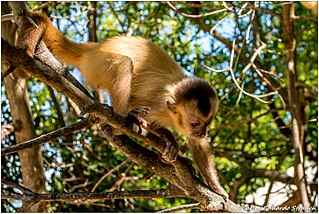
The Kaapori capuchin, also known as the Ka'apor capuchin, is a species of frugivorous, gracile capuchin endemic to the Brazilian Amazon. Their geographical home range is relatively small and is within the most densely populated region of the Amazon. With the strong human presence nearby,C. kaapori has had to deal with very large amounts of disturbances to their habitat and is one of the most endangered of the neotropical primates.

A riparian zone or riparian area is the interface between land and a river or stream. In some regions, the terms riparian woodland, riparian forest, riparian buffer zone,riparian corridor, and riparian strip are used to characterize a riparian zone. The word riparian is derived from Latin ripa, meaning "river bank".
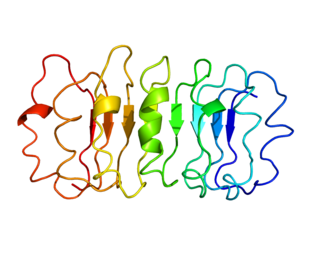
The thyrotropin receptor is a receptor that responds to thyroid-stimulating hormone and stimulates the production of thyroxine (T4) and triiodothyronine (T3). The TSH receptor is a member of the G protein-coupled receptor superfamily of integral membrane proteins and is coupled to the Gs protein.
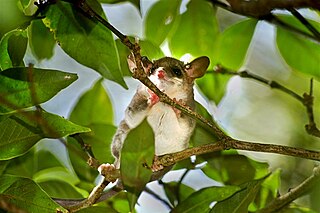
The gray slender opossum, is an opossum species from Brazil.

Cardinia is a town in Victoria, Australia, 52 km south-east of Melbourne's Central Business District, located within the Shire of Cardinia local government area. Cardinia recorded a population of 342 at the 2021 census.

The black-breasted buzzard is a large raptor endemic to mainland Australia. First described by John Gould in 1841, it forms part of the family Accipitridae and is most closely related to the square-tailed kite. It is a versatile hunter known for its special skill in cracking eggs. The species is common throughout most of its range.

The smooth-coated otter is an otter species occurring in most of the Indian subcontinent and Southeast Asia, with a disjunct population in Iraq. It is listed as Vulnerable on the IUCN Red List since 1996 and is threatened by habitat loss, pollution of wetlands and poaching for the illegal wildlife trade. As its name indicates, its fur is smooth and shorter than that of other otter species.
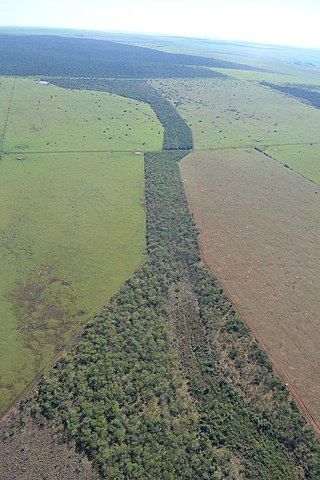
A wildlife corridor, habitat corridor, or green corridor is an area of habitat connecting wildlife populations separated by human activities or structures. This allows an exchange of individuals between populations, which may help prevent the negative effects of inbreeding and reduced genetic diversity that often occur within isolated populations. Corridors may also help facilitate the re-establishment of populations that have been reduced or eliminated due to random events. This may potentially moderate some of the worst effects of habitat fragmentation, wherein urbanization can split up habitat areas, causing animals to lose both their natural habitat and the ability to move between regions to access resources. Habitat fragmentation due to human development is an ever-increasing threat to biodiversity, and habitat corridors serve to manage its effects.
The Angel Island mouse, or La Guarda deermouse, is a species of rodent in the family Cricetidae.

Natriuretic peptide precursor C, also known as NPPC, is a protein that in humans is encoded by the NPPC gene. The precursor NPPC protein is cleaved to the 22 amino acid peptide C-type natriuretic peptide (CNP).

Endothelin receptor type B, (ET-B) is a protein that in humans is encoded by the EDNRB gene.

Elongation factor 1-beta is a protein that in humans is encoded by the EEF1B2 gene.

TNFAIP3-interacting protein 1, also known as ABIN-1, is a protein that in humans is encoded by the TNIP1 gene.
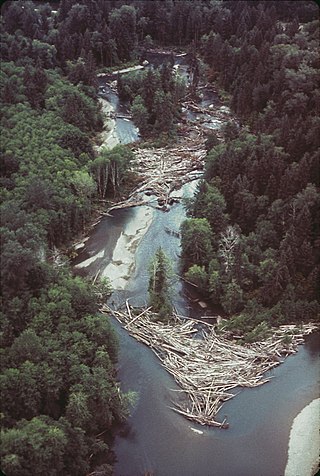
A log jam is a naturally occurring phenomenon characterized by a dense accumulation of tree trunks and pieces of large wood across a vast section of a river, stream, or lake. Log jams in rivers and streams often span the entirety of the water's surface from bank to bank. Log jams form when trees floating in the water become entangled with other trees floating in the water, or become snagged on rocks, large woody debris, or other objects anchored underwater. They can build up slowly over months or years, or they can happen instantaneously when large numbers of trees are swept into the water after natural disasters. A notable example caused by a natural disaster is the log jam that occurred in Spirit Lake following a landslide triggered by the eruption of Mount St. Helens. Until they are dismantled by natural causes or humans, log jams can grow exponentially as more wood arriving from upstream becomes entangled in the mass. Log jams can persist for many decades, as is the case with the log jam in Spirit Lake.

Placostylus ambagiosus is a species of flax snail, a large air-breathing land snail, a terrestrial pulmonate gastropod mollusc in the family Bothriembryontidae.

In molecular biology, mir-145 microRNA is a short RNA molecule that in humans is encoded by the MIR145 gene. MicroRNAs function to regulate the expression levels of other genes by several mechanisms.
The anthropause was a global reduction in modern human activity, especially travel, that occurred during the COVID-19 pandemic, particularly in March and April 2020. It was coined by a team of researchers in June 2020 in an article discussing the positive impact of the COVID-19 lockdown on wildlife and environment. The scientific journal that published the commentary, Nature Ecology and Evolution, selected the topic for the cover of its September issue, with the headline "Welcome to the anthropause". Oxford Languages highlighted the word "anthropause" in its 2020 Words of an Unprecedented Year report.

















